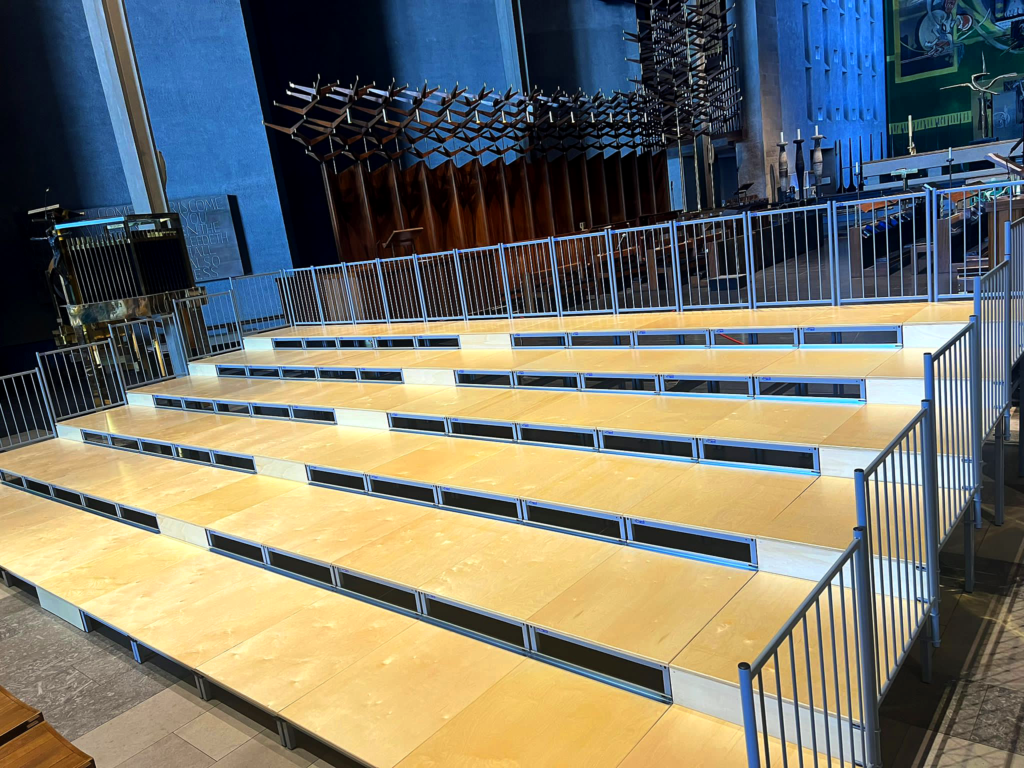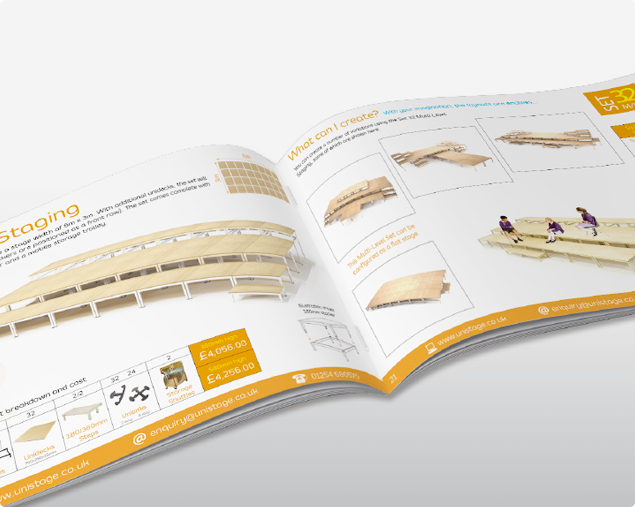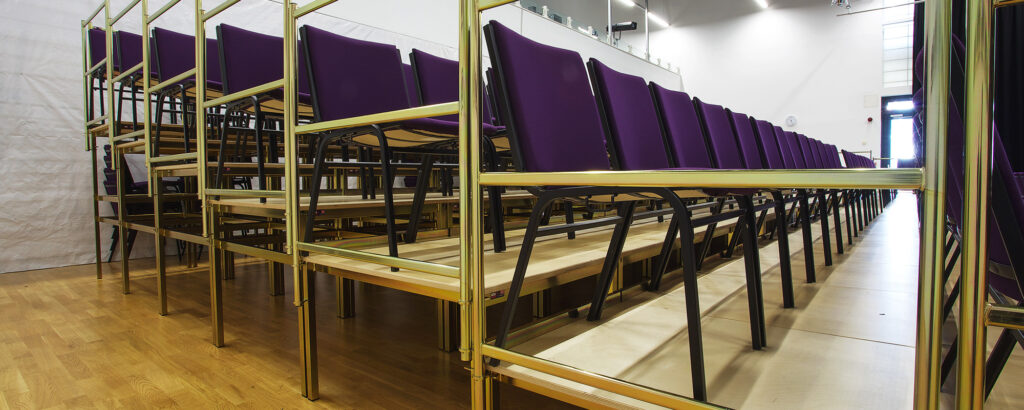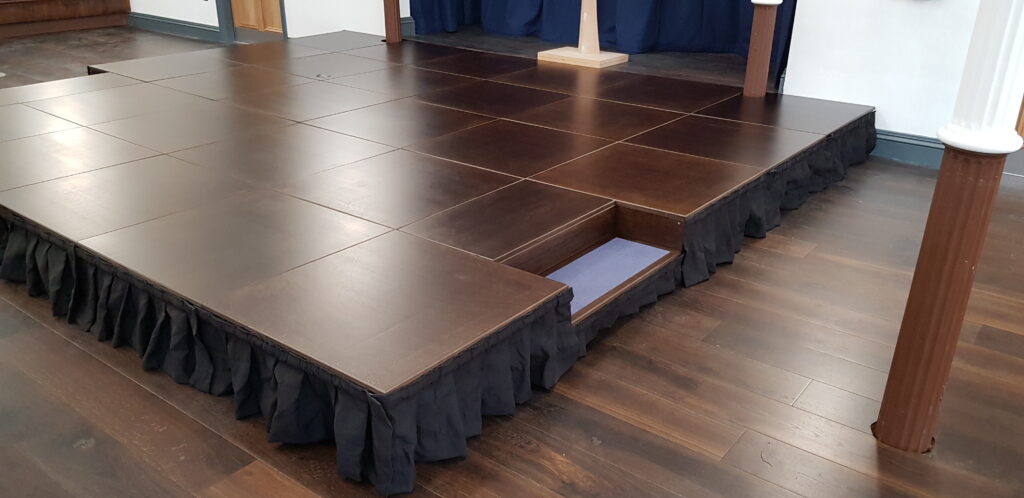free stage
design!
We create bespoke stage solutions
Looking for a custom stage? Speak to our team
The History Of The Stage from Ancient Greece to UniStage Portable Staging
5Oct, 2015
As one of the UK’s leading Portable Staging suppliers it’s always interesting to us to look back at the evolution of the stage, and in this series we’re looking at the journey of the Stage from Ancient Greece to now, delving deep into history over 2000 years to the times of Thespis, Phrynichus and the very origins of the stage in Ancient Greek theatre. This is an exhaustive history of the stage.
Part One: Ancient Greek Tragedy & Deus Ex Machina
The very origins of the first stages coincide with the very origins of the first theatre, in the Dionysia festival of Attica, though most concur the festival’s true origins lie before any connection to the God Dionysus- God of Wine-Making, Ritual Madness and Fertility- who gave it his name.
Whilst the festival’s deepest roots took place in rural settings, it was the upgraded City festival of Dionysia which brought about the construction of the first recognised theatres and with it, the stage.
Held within what today is recognised as March-April but at the time was selected as the one period the Greek Lunar cycle crossed paths with the Vernal (Spring) Equinox, or the end of winter, it’s believed the festival celebrated the passing of harsh times and the successful harvest of crops.
As part of the festival, a procession was followed by contests of singing (solo and choir), dancing & the performance of that year’s written texts by a single actor. The first recorded year this festival took place was 508BC.
When The Persians Destroyed Athens
In 408BC, Athens was destroyed by the Persian Empire, requiring a full rebuild. Following this, the Greek Tragedy’s importance to Ancient Greek society took on a far greater importance and Dionysia was celebrated twice a year, rather than once.
The Theatre Of Dionysus (seen above in its current day ruins) was built sometime between then and 6BC, and although historians have proved the earliest stone fragments found in the building from 6BC, most argue the actual construction was likely many years earlier
In 5BC, it was written that 5 days for every festival were set aside for theatrical performances- at that point inclusive of up to three actors- with three days at least reserved for tragedies and a further day for satyrs, comedic takes on mythical issues.
The Dionysian Arcade
Other profound theatrical spaces of the time, included the Odeon Of Herodes Atticus were constructed to the same instruction as Dionysus. Holding anything between a few hundred to up to 17,000 these theatrical spaces included tiered seating, a spherical pit for the Orchestra and the Scena– the end on performance space, which was initially little more than just that- a raised platform.
The audience seating space was referred to as the Theatron, which translates literally as “the watching space” and would evolve semantically to form the word Theatre in subsequent years, which encapsulated all three areas: Theatron, Orchestra & Scena.
Of the course of the next decade, Scena in both Greece and Rome would evolve dramatically, with far more elaborate, expensive designs and structures. In particular, tall Scenas came into demand as it was deemed poor practice for a character’s death to be shown in person at the time. Archways were constructed to highlight a character’s entrance to and exit from the stage at right and left.
In addition amongst these structural designs were several specialised architectural components:
Breaking Down The Scena Stage…
The Greek Scena made specific use of a fixed series of fixtures to establish dramatis personae of their characters.
The Mechane
Ever heard the quippy phrase “Deus Ex Machina”, that is loved and adored by literary scholars, and wondered where on earth it came from?
The Mechane was a large wooden crane, comprised of struts and pulleys that was used to lift an actor into the air for a grand entrance onto stage from above, almost exclusively for actors who were playing Gods.
As we’ll see in Part 2, when the Romans adopted the stage from the Greeks along with its mechanics, they formed the latin phrase “Deus Ex Machina”, which translates literally as “God on the Machine”. Whilst, in modern times, it has evolved into a metaphor to describe sudden and overwhelming plot twists, its original meaning was a very literal one.
The Ekkyklêma
Essentially a free-wheeled piece of platform, the Ekkyklêma’s initial function was to reveal characters who had died off-stage (i.e. all of them) to the audience. In a broader sense, it also could bring scenes that had otherwise been performed in vocals only before the crowd.
In later and more creative times, the Ekkyklêma became a popular option in Satyr plays, as it’s particularly melodramatic entrance lended itself strongly to parody.
Trap Doors
Trap doors are a famous theatrical technique which are still in use to this date, albeit often now accompanied by electrical lifts and smoke machines.
In Ancient Greece, trap doors were used in dramas to symbolise characters falling or becoming trapped in hell, and of course became favourites in comedies due to the slapstick nature of an actor unwittingly falling bang through the floor at highly comedic moments.
Nowadays, mechanic trapdoors/lifts are big favourites for grand live entertainment shows such as circus, elaborate live music shows and opening/closing ceremonies such as The Olympic Games, proving this age-old technique has lost none of its dramatic impact.
Pinakes
Drawn on wood, fabric or indeed expensive stone, Pinakes were elaborate drawings which could depict scenes, short stories or, in the theatre’s case, backdrops to the performance.
Thyromata served as much larger designs which could and would often span the width of the whole Scena. Often times, these designs would be hung a level up from the floor of the stage, to match the eye-level of the centre of the Theatron.
The vast majority of these components would go on to remain a staple of the stage for many centuries, and tracking the evolution of these components will prove to be a fascinating journey.
Stepping Towards The Future
Around the same time Ancient Greek theatre was developing the Mechane, and its ever expanding Thyromata, theatre was spreading north-west up the coast of mainland Europe into the Roman Empire on its way, eventually, to England.
In Italy, the renowned intelligence, class and artistry of the latin masters would see theatre evolve beyond the traditional spiritual and religious orientated characters of the Greeks. More humanistic characters would be developed, locations would be expanded and new theatrical techniques would be developed.
As for the stage, it would see physical expansions, grander designs, and the creation of new ‘rooms’ including brothels, temples and houses. Our journey takes a pit-stop in Rome but it’s Medieval England where the next great additions were made to the stage and it’s Medieval England where we will visit in Part Two.
Read Part Two here.
Recent Case Studies

Coventry Cathedral
Complete seated tiering installGrab a copy of our brochure

our free
brochure
Can we send you a design of how your stage may look?
Download a copy of free our most recent brochure for more information on our products and services. You will be able to browse stage options and accessories.





